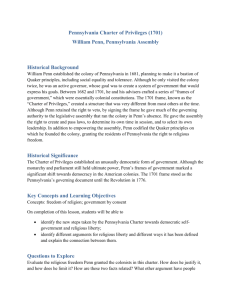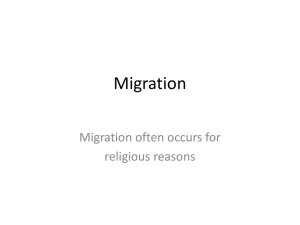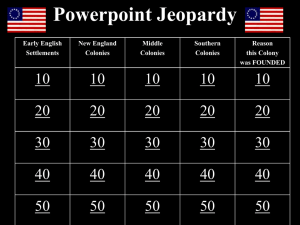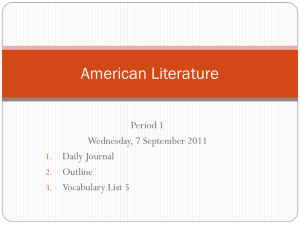John Winthrop v William Penn Reading - mrsarro
advertisement
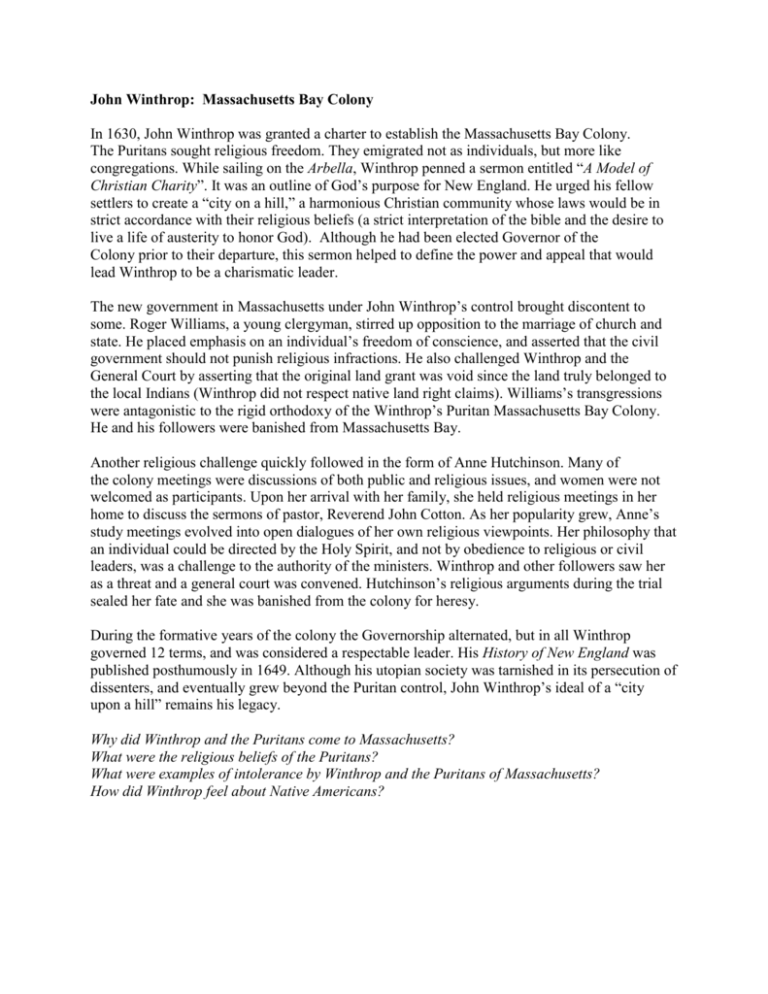
John Winthrop: Massachusetts Bay Colony In 1630, John Winthrop was granted a charter to establish the Massachusetts Bay Colony. The Puritans sought religious freedom. They emigrated not as individuals, but more like congregations. While sailing on the Arbella, Winthrop penned a sermon entitled “A Model of Christian Charity”. It was an outline of God’s purpose for New England. He urged his fellow settlers to create a “city on a hill,” a harmonious Christian community whose laws would be in strict accordance with their religious beliefs (a strict interpretation of the bible and the desire to live a life of austerity to honor God). Although he had been elected Governor of the Colony prior to their departure, this sermon helped to define the power and appeal that would lead Winthrop to be a charismatic leader. The new government in Massachusetts under John Winthrop’s control brought discontent to some. Roger Williams, a young clergyman, stirred up opposition to the marriage of church and state. He placed emphasis on an individual’s freedom of conscience, and asserted that the civil government should not punish religious infractions. He also challenged Winthrop and the General Court by asserting that the original land grant was void since the land truly belonged to the local Indians (Winthrop did not respect native land right claims). Williams’s transgressions were antagonistic to the rigid orthodoxy of the Winthrop’s Puritan Massachusetts Bay Colony. He and his followers were banished from Massachusetts Bay. Another religious challenge quickly followed in the form of Anne Hutchinson. Many of the colony meetings were discussions of both public and religious issues, and women were not welcomed as participants. Upon her arrival with her family, she held religious meetings in her home to discuss the sermons of pastor, Reverend John Cotton. As her popularity grew, Anne’s study meetings evolved into open dialogues of her own religious viewpoints. Her philosophy that an individual could be directed by the Holy Spirit, and not by obedience to religious or civil leaders, was a challenge to the authority of the ministers. Winthrop and other followers saw her as a threat and a general court was convened. Hutchinson’s religious arguments during the trial sealed her fate and she was banished from the colony for heresy. During the formative years of the colony the Governorship alternated, but in all Winthrop governed 12 terms, and was considered a respectable leader. His History of New England was published posthumously in 1649. Although his utopian society was tarnished in its persecution of dissenters, and eventually grew beyond the Puritan control, John Winthrop’s ideal of a “city upon a hill” remains his legacy. Why did Winthrop and the Puritans come to Massachusetts? What were the religious beliefs of the Puritans? What were examples of intolerance by Winthrop and the Puritans of Massachusetts? How did Winthrop feel about Native Americans? William Penn: Pennsylvania Colony William Penn is the famous founder of Pennsylvania. Penn father had loaned money to the English King, Charles II. As his father’s heir, William Penn inherited the family properties and fortune at his father’s death. Rather than repayment of the loan, Penn brokered a grant for a vast parcel of land in North America. Although it is often incorrectly assumed that the colony was named after William Penn, it was named in honor of Penn’s father because the king insisted that “Penn” be attached to the proposed name of “Sylvania.” Penn wished to construct a new government framework for the colony. He had grand designs for his “Holy Experiment.” Immediately after forming his new colony, William Penn published promotional tracts marketing the rewards and advantages of moving to Pennsylvania. English, Welsh, German, and Dutch Quakers traveled to Pennsylvania to worship freely. Penn promoted religious tolerance and freedom, ideals which became some of the fundamental principles of American civil liberties. Ironically, Pennsylvania’s religious environment supported so much migration that the Quakers quickly found themselves a minority in their own settlement. William Penn was a devoted governor and designed the grid layout of Philadelphia, his “City of Brotherly Love.” He was also paramount in forming relationships with the local tribes of Indians. He treated them with respect and learned their native dialects so he could directly work with them. He secured a peace treaty with the Delaware Indians, in which the Indians were paid a fair price for the use of their land. Penn and the Quakers also believed in an enlightened criminal code. Rather than punishment, they sought to reform criminals. Though the colony was a success, Penn would spend only a handful of years in Pennsylvania. Upon his return to England, Penn left the government of Pennsylvania in the hands of a council. He continued to work for religious and legal liberty in Pennsylvania and England at a time of great political and religious upheaval. Various financial and legal battles in both locations plagued him in his later years. Though Penn traveled back and forth to England, he planned to stay in the New World. Political troubles forced his return to England, however, and in 1712 he suffered an attack of apoplexy which disabled him. William Penn died on May 30, 1718. Why did English, Welsh, and German Dutch Quakers come to Pennsylvania? What were the religious beliefs of the Quakers? What were examples of tolerance by William Penn and Pennsylvania? How did William Penn feel about Native Americans?
